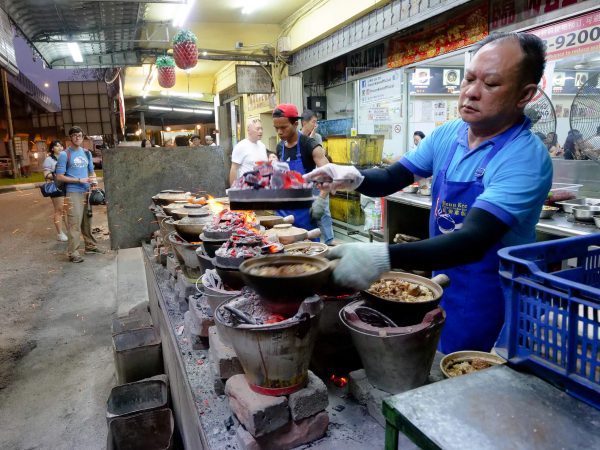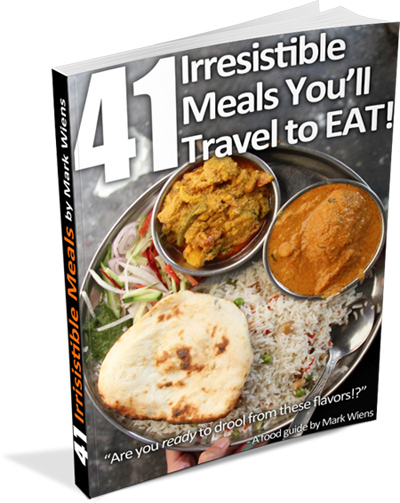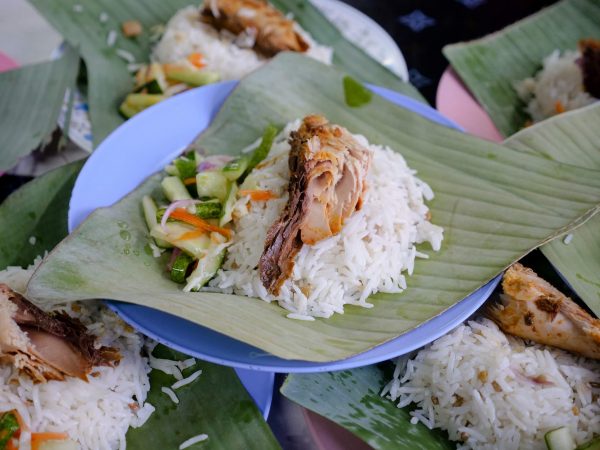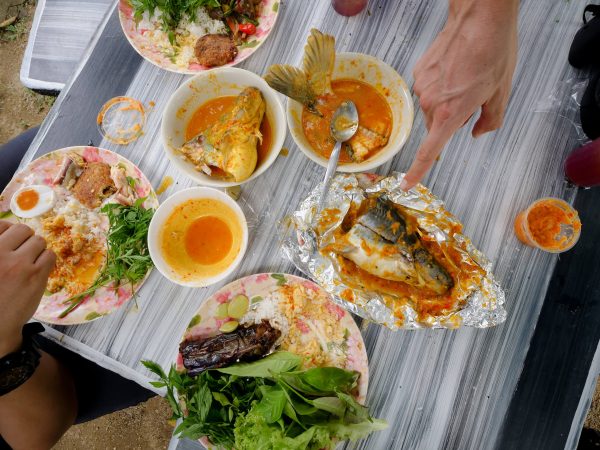
Nasi Ulam, or “Herb Rice,” is a favorite of Malaysian food lovers everywhere! This local Kelantanese food alone will be a highlight for you, any time you visit the amazing northernmost state of peninsular Malaysia.
In this article we will share with you all the herbs, all the seafood, and more info on a ridiculously tasty secret sauce (‘Budu,’ an all-time flavor Champion you NEED to know more about), during this wonderful feast of Kelantanese food at D’Umi Nasi Ulam Restaurant today.

Nasi Ulam (‘Herb Rice’)
Nasi Ulam (or ‘Herb Rice’) might take the number 1 spot for ‘Must-Try’ foods in Kelantan, Malaysia.
Let me reassure you right now, the simple food names* here can’t even begin to describe the variety and the diversity that a meal like “Herb Rice” contains.
I am sure this is one food locals here are recommending to any traveler visiting Northern Malaysia… and you can take it from me that they are all absolutely correct.
So Much More than Herbs, and Rice…
The name ‘Nasi Ulam’ can actually describe a few different foods, but the one eaten daily in Kelantan is simply this:
A meal of white rice with sides of curries, fresh-caught fish (which are grilled), each of these alongside simply gigantic amounts of fresh herbs and raw green vegetables (which you cover in ‘Budu’ and ‘Tempoyak’ local sauces).
Note*: As any lover of South East Asian foods will tell you, food names here do tend to be quite basic, even cute at times! (check out ‘fat rice,’ ‘travel rice,’ and ‘rice salad,’ for some other incredibly delicious Malaysian Local Foods (continuing on to ‘boat noodles‘ and ‘Thai fry‘ for some foods common in Thailand next-door).

Herb Rice Recipes
The amount of vegetation on the serving side-tables here is just wonderful! Don’t feel as though you are personally depleting the store’s entire garden – they go though simply enormous amounts of fresh produce here every day.
All of these veggies here are things you eat with your rice, but more importantly you will be dipping them in a very special sauce of ‘budu’ (we will get to that in a minute).
To get you excited right now, here are just a few of the veggies and herbs you might see at D’Umi Nasi Ulam; jungle pepper (wild pepper), cashew tree leaves, mango tree leaves, Indian pennywort, Vietnamese mint, and even betel nut leaves.
D’Umi Nasi Ulam is one of the best restaurants in this entire area for when you want a full-on lunchtime feast of Kelantan food, so now let’s see a few of the unforgettable main dishes they are serving here.
Note: I recommend a visit here for lunch, but due to their prime location as the first restaurant that all-night truck transports would see when making the border crossing from Thailand, D’Umi Nasi Ulam actually stays open all night, and only closes at 5 in the morning!

Ocean Shrimp
Besides the rice and vegetables making up the nasi ulam herb rice combo itself, there are also a few other dishes here you need to know about.
Get exclusive updates
Enter your email and I’ll send you the best travel food content.
This shrimp is a food you have to order from one of the trays in front, and are they ever huge!
Its not so common to see such large shrimp being sold at budget lunch-time prices like those at D’Umi Nasi Ulam – however, when you have the abundance of the ocean literally at your doorstep, beautiful things like this become daily possibilities.
The coconuty orange sauce is so creamy its almost nutty. The sauce is sweet, but not overly so, and I think this shrimp and curry plate goes very well with a slightly bitter herb. From the nasi ulam herb plate selections, choose a few for yourself, and see how the gentle sweetness is nicely cut with the addition of some brown budu fish sauce.
Herbaceous Tips: I’m not sure of the English name, so just find the herb that looks like cilantro (look for the saw-tooth shape leaf edge). Grab a sprig, and dip up as much shrimp curry broth as you can. Place that onto your rice, adding a dollop of tempoyak on the way, and mix both the herb, and the durian paste, into your brown budu fish sauce.

Sea Shells in Coconut Broth
One of the more joyous experience an adult eater can have is using your fingers, your teeth, tongue, and lips all as utensils of equal usefulness, working on getting out the single slurp of meat from each one of these shells.
Eating a few foods quite similar to this during time spent in Indonesia, I like how the Malay version has a slightly longer lasting spicy feel to each bite.
The sharp end of each shell has already been broken off for you, and so all you need to do is find the right angle where no air can pass through. Practice your technique of slurp, suck, smack, and repeat, building up a small mound of empty shells next to you ’til they’re gone!

Grilled Fish (Ikan Bakar)
I think this is a mackerel that they’re grilling here, but I have never seen such wonderfully large mackerel fish – the rear section of the mature mackerel is like armour plating!
Breaking into the tail however does yield plenty of good bites of white fish meat. Just be careful that you don’t injure yourself in the process.
At D’Umi Nasi Ulam, the chefs do things a bit differently – spreading the sambal spicy chili mash inside the fish body! After this, they close it up again, resting it on the grill for a second time (doubling the flavour infusion!)
The smoke infusion into that sambal magnifies the already delicious fish meat – this is a move of genius, and this is one dish that you have to try during your meal here.
Malaysia’s Favorite Fish: The recipe here at D’Umi Nasi Ulam is quite different than some of the other varieties we had during our time in both Kuala Lumpur (at KL grilling-sensation Ikan Bakar Bellamy), and different than many grill restaurants in Melaka (seafood feast at Hj Haji Musa).

How to Eat Nasi Ulam
(The photo above is not a food on its own, but this is a mandatory move – you need Tempoyak)
Don’t forget to grab at least one small plate of that deliciously murky sauce as well – its name is ‘Budu,’ – it is a salty and sour dip, packing some truly intense, mind-blowing flavor.
I am pretty sure its something that you’ll be telling your friends about whenever you get back from visiting Kelantan, and maybe even something you’ll consider smuggling home (but you didn’t get that idea from me…).
The sauces and side dishes are key parts of a full meal of Nasi Ulam, and so don’t be afraid to go all out here – use the tongs where provided, and your hands when necessary, and stack for yourself at least one plate per person of all those fresh herbs, raw vegetables, whole chilies, limes, and bean sprouts.
Warning – Running out of Budu Sauce is Not Ideal
I only want to mention this so that you don’t forget (and trust me, when I am faced with grilled fish and Tempoyak, it really can be hard to think of anything else around me).
The way you eat at this restaurant is by first walking up to the front counter, choosing your main dishes, and then building your own mini-plates of ‘budu’ sauce, tempoyak (the huge plastic container in the picture above), and picking from the plates of herbs and fresh vegetables.
Stock up, because you are going to want to make sure that at no time during this meal, do you or any of your friends run out of this brown and fishy dipping sauce called ‘budu.’

Budu Sauce
Although this is ‘just’ a sauce, I am definitely going to include this as a food unto itself (this food is on my short list of reasons for why travel to Malaysia is a joyous and annual necessity).
This Malaysian ingredient I can only describe as heavenly, and I guarantee you that the flavor possibilities it opens will change the way that your mouth thinks about food.
‘Just’ a Sauce… Ha!
A very simple combination of fish meat (anchovy) and salt, similar types of dip to this are common in nearly every country in all of South East Asia.
Honestly my saliva glands are working overtime right now, even as I write this from home – the memories of Budu sauce are still so fresh on my tongue.
Southern Thai Style: Budu is also eaten in Southern Thailand, but I must admit, I think the Malay version has won me over. This is one ingredient that I’m willing to smuggle home in my carry-on, and you do not want to leave Malaysia without having a full-on experience of your own with this most glorious combo of condiments.

How to Eat with Budu
Grab one of those pre-made mix plates (the budu sauce, chilies, slices of mango, and a wedge of lime) and stir for yourself a magic potion – the final addition being a scoop of fermented durian.
Mix it up, and spoon some onto your rice. Grab a hunk of meat from the grilled fish, and mash the fish meat ever so slightly with your fingers (this makes it easier to pick up, but watch out for its bony back section). Moving in gently, press together with your fingers, swoop towards your mouth, and elevate your tastebuds to temporary paradise.
Every bite is always up to you… but when in such close proximity to magic, I think its mandatory to make sure everything on the table goes with at least one healthy dose of pungent, delicious, Malaysian budu.
The final step is to mix Budu with Tempoyak
Our worlds were rocking while having Tempoyak for the first time, just a few days before our visit to Kelantan… but that was just Tempoyak on its own! Little did we know, locals here in Kelantan delight in mixing Tempoyak with budu, and then adding in fresh home-grown entire chili peppers!*
Its unbelievable, it is Flavor Overload Level 10, this is a taste that the whole world needs to know about.

Get Your Probiotics!
Not only is Budu sauce delicious, its even healthy for you! Eaten centuries before the current probiotic health-food trends sweeping the Western world (fermenting drinks using kefir grains, kombucha, etc.), Malaysia’s Budu sauce is full of amazing, halophilic bacteria cultures.
I won’t go into the details (you can read more here), but just know that the chefs controlling this fermentation target very specific salt-fish-palm-sugar-to-tamarind ratios. They want to get just the perfect environment for these bacteria to thrive… and I support these tasty goals 100%.
Note*: People also do this in Terangganu (bordering state of Kelantan), but their ratio is heavier on the Tempoyak, whereas it seems that Kelantan goes heavier on the salty Budu (both ways are perfect).

Best Things About Malaysia
One of the best things about food in Kelantan is how local recipes uniquely combine the jungle ingredients and spice-loving style of central Malay cooking with teeming amounts of seafood from Malaysia’s northern shores.
A visit to Kelantan will take you about half a day’s journey away from the more well-known, well-traveled parts of Malaysia, and one of the best parts about this is that you have the same food-love, the same flavor addiction shared throughout this amazing country of Malaysia!
Thank you for reading this article, and I hope you enjoy several more articles on this website – we have content from our entire trip around this amazing country of Malaysia, and enough photos to guarantee (even for ourselves) that the ‘next trip to Malaysia’ is always just around the corner!
Much love, thanks for reading!
Name: D’Umi Nasi Ulam
Location: (Google Maps)
Hours: 10am to 5am (yes, late night hours! but they are Closed on Fridays)
Prices: The owners here are so incredibly kind, giving us this meal complimentary (when you visit, expect to pay around 15-20RM per person when having a full lunch like the one you see in these photos)
Get exclusive updates
Enter your email and I'll send you the best travel food content.



